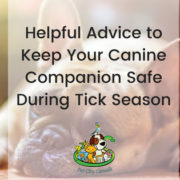Helpful Advice to Keep Your Canine Companion Safe During Tick Season
Did you know that Lyme disease and tick-borne illnesses are on the rise in many parts of Canada? These illnesses are not only a concern for your canine companion but for you as well! Being aware of the signs and symptoms of tick exposure is your first line of preparedness. As the weather warms up, so does the tick population. Ticks can be found in woodlands, urban parks, or your own backyard. Monitor your pet’s skin and fur after every outdoor activity to keep them tick free and healthy. Regular grooming, with a professional, experienced groomer, can help in detecting ticks and other ailments as well.
Ticks are the size of a small poppy seed during the nymph stage; pretty hard to detect with an unsuspecting eye! They are usually brown or black in colour and have 8 legs. Ticks are unable to jump or fly so they wait patiently for a host to pass through low branches or long grass, then they attach themselves quickly to man or beast. Once attached, they feast on the blood of their victims, often leaving behind illness. If left untreated, symptoms can become debilitating and chronic. Don’t be fooled – ticks also can reproduce in your home. They hide in carpets, curtain hems, cracks, and behind radiators.
Tick Prevention:
- Keep tall grass, bushes, and shrubs in your yard trimmed.
- Rake up leaves and garden debris regularly.
- Mow lawn often to keep it short.
- Use an approved garden insecticide under bushes and shrubs, under porches, and along fence lines, (follow instructions listed on container).
- Use Veterinarian approved products and shampoos for tick removal.
- Wash animal bedding and mats often.
Tick Warning Signs and Symptoms:
- Run your hand slowly through your pet’s fur feeling for any slight bumps or unexplained scabs, (pay close attention to the head, neck, ears, eyes, and paws in between the toes).
- Monitor your dog’s behaviour for signs of scratching, skin irritation, or infection.
- Symptoms of Lyme disease in dogs are fever, joint pain, decreased appetite, and swollen lymph nodes. When the disease has progressed, it brings possible kidney disease and/or tick paralysis.
- Some communities encourage you to submit the tick to your local health authority for testing. Check with your municipality to find out local regulations.
How to Safely Remove a Tick:
- Ticks must be removed as soon as they are found!
- Keep disposable gloves specifically for removing ticks.
- Use tweezers to grasp the tick by its head as close to the skin as possible.
- Pull the tick straight out, don’t twist! Make sure you have removed the whole tick, (keep it in a plastic bag with isopropyl alcohol in case your dog shows signs of illness later)
- The tick will be full of blood if it’s bloated. Don’t push or squeeze the body as this may force contaminated blood back into your pet.
- Thoroughly wash the bite area with soap and warm water.
- Disinfect tweezers with isopropyl alcohol after use.
When to Consult a Veterinarian:
- Always consult your Veterinarian if you suspect something is wrong with your pet.
- Ask about vaccines that are safe in protecting your dog against Lyme disease.
- When you want to start using flea and tick collars, medications, tick-repelling chemicals, or any other products for tick prevention.
- If you find a tick on your pet consult your Veterinarian who may want to do a blood test to rule out any questionable diseases.
There are up to 15 different tick born diseases associated with ticks. Please consult your Veterinarian for prevention and treatment products recommended for your area. Remember that you can’t contract any tick illnesses directly from your pet.
The best ongoing maintenance program for your dog is having regular assessments and treatments done by a reputable dog grooming company. The highly skilled Pet Groomers at Pet City Canada will monitor your pet’s skin and coat for any parasites or abnormalities. Call today to book your full-service grooming. You can also read more about how to choose a pet groomer on our blog 3 Important Considerations When Choosing a Pet Groomer.


